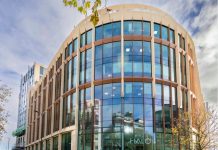Savills has launched its latest spotlight report, ‘Cambridge: A city state of mind?’: Cambridge has been one of the key global success stories over the past decade, but it needs to evolve and adopt new strategies to remain in a position of strength in a post-Brexit world.
Savills research shows that Cambridge has attracted more than £8.25 billion of corporate investment (VC, M&A and private equity) in 2017, compared with the five-year annual average of £7.87 billion, as the city continues to attract multinational office and lab occupiers and competes as a key global innovation hub.
An obvious growth area for the Cambridge economy is an increase in technology businesses, in particular Artificial Intelligence (AI) and cyber security. Data analysed by Savills shows that total corporate investment for the cyber security sector in the city for the three-year period of 2015 to 2017 has seen growth of more than 3,000% compared to the preceding three years (2012-2014). The comparable figure for AI is almost 2,500%. In contrast, although still an impressive figure, the more traditional life sciences sector has seen just 670% growth in this time.
To put this into a real estate context, Savills figures show that in the first half of 2018 technology businesses transacted 103,636 sq ft (9,628 sq m) of space, accounting for 55% of all take-up in the city. For instance, Samsung has recently committed to opening a new AI hub in Cambridge, which will add to the already growing cluster of mature AI developers, such as Microsoft, and start-up firms.
Darktrace is another example, having raised $180 million of funding since its inception in 2013 from global investors including KKR and Softbank. The cyber security firm is about to move into new office space totalling 19,813 sq ft (1,840 sq m) at the Maurice Wilkes Building on St John’s Innovation Park, an increase in floor space of circa 692% in the past five years. Similarly, Prowler IO, a growing AI platform, recently moved from 4,500 sq ft (418 sq m) to 26,000 sq ft (2,415 sq m) at 72 Hills Road in just two years.
Rob Sadler, head of office at Savills Cambridge, comments: “The University of Cambridge is due to play a large role in the growth of the AI sector having received £10 million in funding to develop a new supercomputer which will enhance the research capabilities of these companies. With a limited supply of AI experts across the UK, this is likely to create and attract new talent to the city. What’s more, the UK Government’s AI Deal is worth more than £1 billion and Cambridge is well placed to capitalise on increasing interest in the sector.”
Savills notes that the future of Cambridge rests on its ability to continue to establish these growth sectors and new workspace is appearing to assist with this ongoing evolution. The start-up community in Cambridge remains buoyant, but at present demand outweighs supply. The Bradfield Centre in Cambridge Science Park, opened this year, is a new 40,000 sq ft (3,716 sq m) facility dedicated to housing start-ups, however, this alongside St John’s Innovation centre are the only large co-working schemes currently available. Savills is aware of more than 100,000 sq ft (9,290 sq m) of requirements from serviced office operators looking for space in Cambridge, which if realised could help further advance tech innovation in the city.
With a growing international reputation for AI capability and strong connections to sources of capital, Cambridge is likely to compete at the highest global level within the bioscience and technology fields, especially with places such as Cambridge, Massachusetts (MA) in the US. Brexit uncertainties and a weaker sterling rate compared to the dollar means that salaries are by far the biggest cost and differentiating financial factor in locating a corporate business, with UK wages currently at a significant discount to the US in this sector.
Rob Sadler, adds: “We are very well placed to take advantage of the discounts created by Brexit and attract and retain global firms. What we now need to do is make sure we can meet their requirements by providing appropriate office space, robust infrastructure and affordable housing for staff coming to work in these new emerging sectors within Cambridge.”
From a residential property perspective, Cambridge is a city facing the same challenges as London, and increasingly patterns seen in London are played out in Cambridge. Like the capital, affordability remains challenging and developments outside the city, in necklace villages, have seen an increase in demand as a result.
Cambridge also mirrors the London market’s response to political uncertainty, stamp duty hikes and the targeting of buy-to-let mortgages. Political uncertainty is likely to be the overriding factor in the market for the next six months and, although we anticipate buyer uncertainty over Brexit will inevitably lead to inactivity, there will be room for growth in the longer term.
As in London, affordability in Cambridge remains a challenge. Pressure on the city means hinterland locations are seeing increasing demand. Within the city, our latest report shows the median house prices to be 13.5 times greater than median annual earnings. By comparison in the neighbouring local authorities of South Cambridgeshire, Huntingdonshire and East Cambridgeshire house prices are 11.0, 8.7 and 9.8 times earnings respectively – and although still a concern for many would be buyers, these locations are not as stretched as those seeking to buy in Cambridge itself, so those looking for value will look to these areas The city has a strong residential development pipeline and in our report we have identified sites with capacity for over 17,000 homes either in planning or currently under construction in the city. However, much of the new development currently available is aimed at the top end of the market, the average value in the year to June 2018 for a new build house was £814,865, 33% higher than the average for second-hand houses. This difference, combined with limited supply, is helping to hold up values in the second-hand sector. In contrast, in South Cambridgeshire, new build values were 1.8% below second-hand values and will look attractive by comparison.
Uncertainty is likely to be the driving force in the Cambridge residential market for the next couple of years as the UK negotiates its exit from the European Union. But where international buyers may have slowed, the international rental market is still healthy. Cambridge is still attracting an international work force, who are increasingly looking to the rental market. According to Savills deal book data In 2016 and 2017, 29% of new lettings were to European tenants. Once the future of the UK’s relationship becomes clearer, and after the recent correction in prices, there will be room for future growth.
Toby Greenhow, director, Cambridge residential development sales, says: “The average house price to earnings ratio in Cambridge is similar to that of Greater London and therefore constraining for many. If we had a 40% deposit ‘Help to Buy’ product in Cambridge, as there is in London, this would help many more buyers fulfil their dreams of home ownership.”
Overall, Savills believes that Cambridge will keep growing and widening its reach. The fundamentals of a buoyant commercial market coupled with a return to growth in the residential market, once the uncertainty of Brexit is resolved, means that the city will continue to be viewed as competitive in a global market.






















